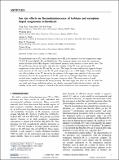Files in this item
Ion size effects on thermoluminescence of terbium and europium doped magnesium orthosilicate
Item metadata
| dc.contributor.author | Zhao, Y. | |
| dc.contributor.author | Zhou, Y. | |
| dc.contributor.author | Jiang, Y. | |
| dc.contributor.author | Zhou, W. | |
| dc.contributor.author | Finch, Adrian Anthony | |
| dc.contributor.author | Townsend, P.D. | |
| dc.contributor.author | Wang, Y. | |
| dc.date.accessioned | 2016-10-31T00:34:01Z | |
| dc.date.available | 2016-10-31T00:34:01Z | |
| dc.date.issued | 2015 | |
| dc.identifier | 233956040 | |
| dc.identifier | c5450d42-7009-4320-8dd0-1be744cc6e39 | |
| dc.identifier | 84959520065 | |
| dc.identifier | 000367252900008 | |
| dc.identifier.citation | Zhao , Y , Zhou , Y , Jiang , Y , Zhou , W , Finch , A A , Townsend , P D & Wang , Y 2015 , ' Ion size effects on thermoluminescence of terbium and europium doped magnesium orthosilicate ' , Journal of Materials Research , vol. FirstView . https://doi.org/10.1557/jmr.2015.329 | en |
| dc.identifier.issn | 0884-2914 | |
| dc.identifier.other | ORCID: /0000-0002-3689-1517/work/38002323 | |
| dc.identifier.uri | https://hdl.handle.net/10023/9737 | |
| dc.description | We would like to thank the support of the Fundamental Research Funds for the Central Universities of China, the National Science Foundation of China (No. 11205134) and Beijing Higher Education Young Elite Teacher Project (YETP0640). The refurbishment of the RLTL system at St. Andrews was funded by NERC grant NE/H002715/1. | en |
| dc.description.abstract | Thermoluminescence (TL) and radioluminescence (RL) are reported over the temperature range 25–673 K from MgSiO:Tb and MgSiO:Eu. The dominant signals arise from the transitions within the Rare Earth (RE) dopants, with limited intensity from intrinsic or host defect sites. The Tb and Eu ions distort the lattice and alter the stability of the TL sites and the peak TL temperature scales with the Tb and Eu ion size. The larger Eu ions stabilize the trapped charges more than for the Tb, and so the Eu TL peak temperatures are ∼20% higher. There are further size effects linked to the TL driven by the volume of the upper state orbitals of the rare earth transitions. For Eu the temperatures of the TL peaks are wavelength dependent since higher excited states couple to distant traps via more extensive orbits. The same pattern of peak temperature data is encoded in RL during heating. The data imply that there are sites in which the rare earth and charge stabilizing defects are closely associated within the host lattice, and the stability of the entire complex is linked to the lattice distortions from inclusions of impurities. | |
| dc.format.extent | 903057 | |
| dc.language.iso | eng | |
| dc.relation.ispartof | Journal of Materials Research | en |
| dc.subject | Radiation effects | en |
| dc.subject | Luminescence | en |
| dc.subject | Optical properties | en |
| dc.subject | GE Environmental Sciences | en |
| dc.subject | QC Physics | en |
| dc.subject | NDAS | en |
| dc.subject.lcc | GE | en |
| dc.subject.lcc | QC | en |
| dc.title | Ion size effects on thermoluminescence of terbium and europium doped magnesium orthosilicate | en |
| dc.type | Journal article | en |
| dc.contributor.sponsor | NERC | en |
| dc.contributor.institution | University of St Andrews. Earth and Environmental Sciences | en |
| dc.contributor.institution | University of St Andrews. Marine Alliance for Science & Technology Scotland | en |
| dc.contributor.institution | University of St Andrews. Scottish Oceans Institute | en |
| dc.contributor.institution | University of St Andrews. St Andrews Isotope Geochemistry | en |
| dc.identifier.doi | 10.1557/jmr.2015.329 | |
| dc.description.status | Peer reviewed | en |
| dc.date.embargoedUntil | 2016-10-30 | |
| dc.identifier.grantnumber | NE/H002715/1 | en |
This item appears in the following Collection(s)
Items in the St Andrews Research Repository are protected by copyright, with all rights reserved, unless otherwise indicated.

